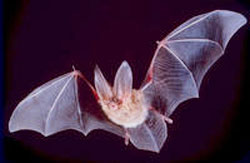Molecular Biology Fills Gaps in Knowledge of Bat Evolution

UCR Biologist Mark Springer, Part of Research Team Publishing in Journal Science
One in five mammals living on Earth is a bat, yet their evolutionary history is largely unknown because of a limited fossil record and conflicting or incomplete theories about their origins and divergence. Now, a research team including University of California, Riverside Biology Professor Mark Springer, has published a paper in the Jan. 28 issue of the journal Science that uses molecular biology and the fossil data to fill in many of the gaps.
Springer coauthors the paper, titled A Molecular Phylogeny for Bats Illuminates Biogeography and the Fossil Record, with William Murphy, Stephen J. O’Brien and Emma. C. Teeling of the National Cancer Institute’s Laboratory of Genomic Diversity, Frederick, MD; Ole Madsen in the Department of Biochemistry at the University of Nijmegen, the Netherlands; and Paul Bates of the Harrison Institute’s Centre for Systematics and Biodiversity Research, Kent, U.K. “The present work advances our understanding of where bats originated, when they diversified and how different bat families are related to each other,” Springer said. “It also quantifies the fraction of the fossil record that is missing for bats.”
The team, using DNA sequencing, analyzed data from portions of 17 nuclear genes from representatives of all bat families. Their results support the hypothesis that the group of large fruit-eating bats from the tropics, that fly mostly during the day – known to biologists as megabats – emerged from four major lineages of smaller and more widely dispersed, mostly insect-eating, night-flying bats, known as microbats. These microbats – also known for their highly specialized echolocation – originated about 52 to 50 million years ago during a lush period of significant global warming in a region that is now North America.
This latest research helps fill gaps in the evolutionary history of one of the most diverse group of mammals on earth and the only mammals capable of powered flight. The fossil record alone left bat evolutionary history about 61 percent incomplete, according to Springer. Bats play a major ecological role as plant pollinators and insect predators.
For Springer, this latest research is significant because it shows that molecular information can contribute to resolving and illuminating long-standing problems in evolutionary biology. The current findings lay the groundwork for further research that, Springer hopes, will expand the coverage of classifications of bats from the family level to the genus level and probe in more detail into the bat evolutionary record. He also plans to compare the completeness of the bat fossil record with that of other mammals.
Related Links:
University of Michigan Museum of Zoology animal diversity Web site
The University of California, Riverside is a major research institution and a national center for the humanities. Key areas of research include nanotechnology, genomics, environmental studies, digital arts and sustainable growth and development. With a current undergraduate and graduate enrollment of nearly 17,000, the campus is projected to grow to 21,000 students by 2010. Located in the heart of inland Southern California, the nearly 1,200-acre, park-like campus is at the center of the region’s economic development. Visit www.ucr.edu or call 951-UCR-NEWS for more information. Media sources are available at http://www.mediasources.ucr.edu/.
Media Contact
More Information:
http://www.ucr.eduAll latest news from the category: Life Sciences and Chemistry
Articles and reports from the Life Sciences and chemistry area deal with applied and basic research into modern biology, chemistry and human medicine.
Valuable information can be found on a range of life sciences fields including bacteriology, biochemistry, bionics, bioinformatics, biophysics, biotechnology, genetics, geobotany, human biology, marine biology, microbiology, molecular biology, cellular biology, zoology, bioinorganic chemistry, microchemistry and environmental chemistry.
Newest articles

Properties of new materials for microchips
… can now be measured well. Reseachers of Delft University of Technology demonstrated measuring performance properties of ultrathin silicon membranes. Making ever smaller and more powerful chips requires new ultrathin…

Floating solar’s potential
… to support sustainable development by addressing climate, water, and energy goals holistically. A new study published this week in Nature Energy raises the potential for floating solar photovoltaics (FPV)…

Skyrmions move at record speeds
… a step towards the computing of the future. An international research team led by scientists from the CNRS1 has discovered that the magnetic nanobubbles2 known as skyrmions can be…





















